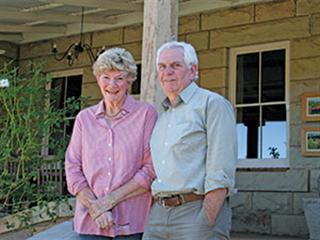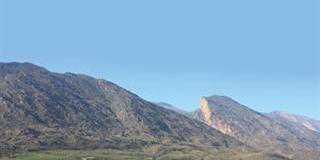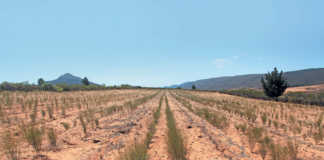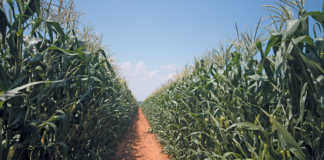
John Critchley is adamant that he is not a farmer and has never aspired to be one, but he has always had an interest in wine. Five years ago, after reading up on cool-climate wine-growing, he took a leap of faith by planting wine grapes on 1,5ha of neglected land in a scenic corner of the Eastern Free State.
John and his wife Trish moved to Fouriesburg in 2006, with the dream of setting up a country retreat for weary city dwellers looking for a weekend escape. After taking occupation of a 15ha stretch of land through an agreement with the farmer who owned the property, they started turning ideas into reality. And so the Rose House was born.
They began by restoring the dilapidated sandstone farmhouse as their own home, and thereafter built a series of guest cottages. A problem remained, however: the unsightly orchard alongside the driveway. With its 3ha of self-seeded fruit trees, burnt pines and wild raspberry canes, this was no setting for a tranquil getaway.
“The soil had been lying fallow for who knows how long,” John recalls. Trish decided to plant lavender on the land, but the frost proved too harsh and the trial crop failed. John, having done a beginners’ winemaking course while working as a quantity surveyor in Johannesburg in the 1980s, saw this as an ideal opportunity to put his theory into practice.
“I began to read many articles about cool-climate wine-growing and the effect of climate change on wine production,” he says. “I realised it wasn’t impossible to produce wine in summer rainfall areas, as winemakers were already doing it in the KwaZulu-Natal Midlands.”
According to the report Climate Change, Wine and Conservation, published earlier this year by Conservation International, South Africa stands to lose 55% of its wine-producing land through climate change in the future. With higher temperatures leading to more drought in the Western Cape, the farming of certain crops could become possible further north, unlocking areas such as the Free State for wine production.
Expert advice
John sought advice from Wellington-based oenologist Johan Wiese, and together they assessed the suitability of the soil, climate and water. But soil analysis conducted by the Agricultural Research Council in Bethlehem was not encouraging. “I was told the soil was very unsuitable, had a pH of 4 and consisted of silty sand in parts, with heavy clay and deep loam in others,” said John. “But we had plenty of good water from springs in the sandstone rock face 1,5km away, and it was ideal for drip irrigation.”
The weather records were more positive: there was sufficient heat in summer for Shiraz and Pinotage. This pleased John as he wanted to stick to red wine production, which requires less infrastructure than white-wine production. With sufficiently low minimum night-time temperatures and temperate daytime highs, good acidity could be achieved in the fruit.
According to Wiese, the high altitude of 1 700m, and cooler night-time temperatures, could result in grapes ripening later than in the Western Cape, providing positive results. “In vintage years with lower rainfall, we can expect good quality and colour from red grapes. I recommended that John start with Pinotage, Shiraz and Pinot Noir, as the first two are low-risk cultivars. For such a new venture, we had to minimise risk,” he explains.
“Pinot Noir is the wild card. It’s planted with great success all over the world in continental climates, but achieving the right quality can be tricky. That’s why I advised that it be planted as a test cultivar in Fouriesburg. The Eastern Free State isn’t a traditional cultivation region and you can get rain during flowering or harvest, as well as late frost. The rainfall in February can also promote diseases such downy mildew and bunch rot.”
Local farmers in the area helped John prepare the land, lending him a tractor to plough and donating 10t of lime. As a trial crop, he planted 1 100 rootstocks from Wiese’s Voor-Groenberg nursery in Wellington. “I saw enough growth in the first planting during the summer of 2008 to be encouraged,” he recalls. “The next year, I increased stock to cover 1,5ha on a gentle 3% slope.”
From then on, it was all about growing, training, and pruning the vines. “I wanted roots and structure to develop before the fruit appeared. I did the pruning with a local assistant, but at that stage it was the blind leading the blind,” he remembers.
Early setback
Disaster struck in December 2010 when the worst hailstorm the district had seen in 25 years demolished the entire 1,5t crop. Much of the second- and third-year growth on the canes was damaged by the hail and had to be cut away, setting the operation back. As a result, the 2011 and 2012 harvests were minimal, but this year’s yield was back to 1,5t and John expects to harvest between 5t and 7t next year.
After the hail, the local farming community once again reached out to the Critchleys, this time donating mounds of second-hand shade cloth to protect the vines during the summer rain. “We now close them up in September for the early thunderstorms, but because the hail only comes from the west, we need to protect only one side,” John explains. “A small amount of hail is beneficial as it boosts the nitrogen content of the soil, as does the snow in winter.” The shade cloth is also used during February and March to enclose the entire vineyard, when the grapes’ high sugar content attracts birds and insects.
Diseases and pruning
John admits that he has been fortunate as far as diseases go; his grapes have suffered only a small outbreak of mildew, which he brought under control with copper and sulphur. “Because we have typical Highveld thunderstorms, the showers are short and the grapes and leaves dry off quite rapidly,” he explains.Pruning is done later than in the Western Cape winelands, towards the end of August to delay bud burst and possible damage by late frost.
“This gives a relatively short growing season, so we have varietals that ripen early. Planting later-ripening varietals would mean there wouldn’t be enough time for the fruit to ripen fully.” Nowadays, John does all the pruning himself and brings in no more than four or five part-time labourers at harvest time to pick the grapes quickly. “Fortunately, all our varietals ripen at slightly different times, so we can stagger the fermentation process. The Pinot Noir ripens first, followed by the Pinotage and then the Shiraz,” he explains.
Advantages of Going ‘garagiste’
A renovated sheep barn on the property has been converted into cellar-cum-restaurant. Trish runs the restaurant, The Rose Hip, while John makes wine in the small room adjoining its kitchen. Not a day goes by that he’s not in the cellar attending to his vintage maturing in second-hand French oak barrels sourced from the Western Cape. He expects to produce 1 000 bottles from this year’s harvest.
Through his research on small-scale red-wine production, John has developed a workable production system for crushing, de-stemming, ageing, stabilisation and filtration. “I’d say we’re within the limits of garagiste – a movement of small-scale winemakers who do it more as hobby than a commercial enterprise,” he explains. “These winemakers are becoming highly sought-after because they’re hands-on. The movement’s grown tremendously in the Western Cape.”
Preventative, not reactionary
John has taken a natural approach to his wine-growing venture by mulching his vineyards with wheat and bean straw and fertilising with earthworm castings. This has increased the soil’s pH level and improved its friability in the upper layers, boosting water infiltration and retention and creating ideal conditions for microbes.
The castings come from John’s small vermiculture project. He keeps about a million red wiggler worms, feeding them on manure sourced from surrounding farms. Since introducing this mulching and composting regime, he’s seen an increase in worm activity around the vines, a clear sign of soil health. The worms have also brought an influx of Guinea fowl and Southern Bald ibis.
“As I intensify the mulching and composting, I use fewer inputs,” John explains. “I also don’t use any herbicides or pesticides, other than copper and sulphur, to control mildew. That’s the benefit of small-scale farming: you can be preventative, not reactionary. My aim is to be non-invasive and create healthier plants that are more resistant to attack. “All this has been a steep learning curve for me.
I now know the importance of listening carefully to neighbouring farmers who have experience of local conditions, and I’m never too proud to ask for advice. “Operations like mine could increasingly provide alternative sites for wine production in response to the loss of traditional vineyard areas because of climate change.”
Email John Critchley at [email protected].













